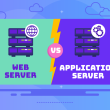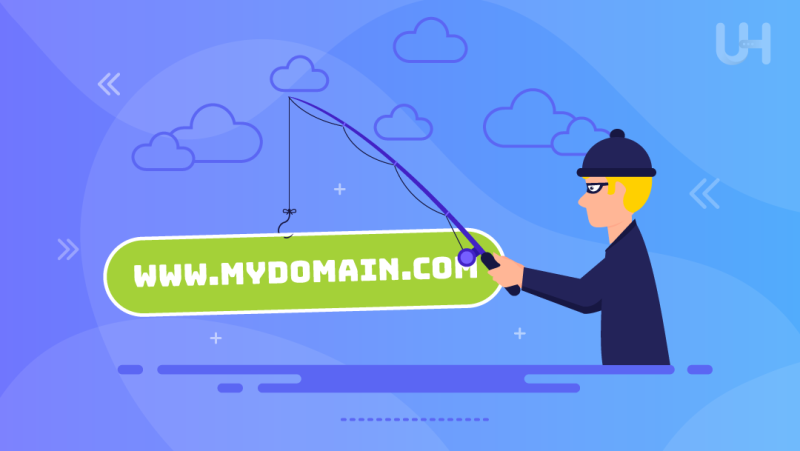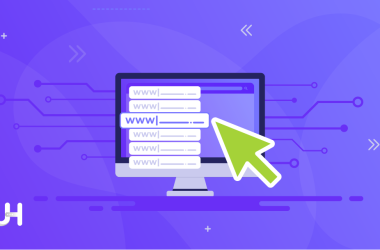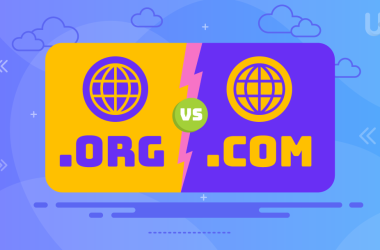A domain name is the web address typed in a browser to visit a specific site. If we talk about UltaHost, then “ultahost.com” would be the domain name to get to this website. The domain name of any website is a huge part of their identity and one of the most valuable assets to access their website. Since it’s such a useful identity, it requires careful protection. With the increasing number of cyber attacks, domain hijacking is becoming a widespread threat to online security. Let’s take a look at its types and methods to prevent it from happening.
What Is Domain Hijacking?
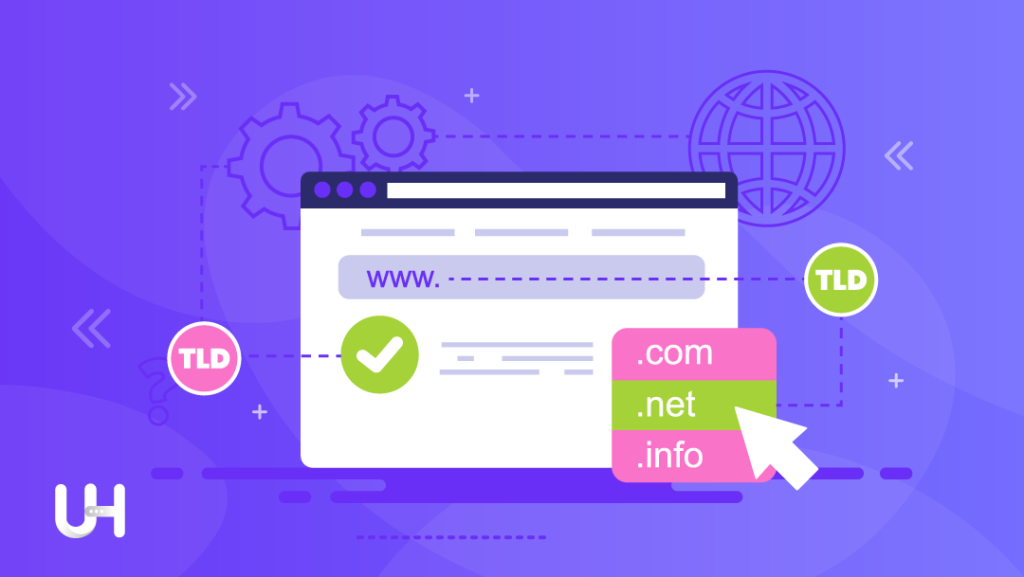
Domain hijacking, also known as domain theft, is a practice that changes the registration of a domain name without the permission of its original owner. In this case, the hijacker gains complete control of the target’s DNS information and uses it to block the owner’s access, make unauthorized changes, or for any other purpose they want.
Domain name hijacking is possible by abuse of privileges on domain registrar systems and domain hosting. Some of its effects are:
- Financial Damages: Online business websites are vulnerable to cyber attacks. When the domain of an e-commerce website is hijacked, it can lose millions of dollars. This proves the importance of having domain privacy protection in place to avoid such events from occurring.
- Reputational Damages: After being in control of the website’s domain, hackers can facilitate additional cyber attacks, such as uploading malware or social engineering attacks. Posting offensive content or scamming visitors negatively impacts the reputation of an organization.
- Regulatory Damages: A domain theft is not only limited to harming an organization; it can also pose a severe risk to visitors having their confidential information stored on that domain. Cybercriminals can create identical web pages through phishing techniques, gain unauthorized access to customers’ data, and compromise sensitive personally identifiable information (PII).
An organization must have proper cybersecurity and web hosting measures in place to prevent these damages. Before we head on to prevention techniques, let’s learn about the types of domain name hijacking.
Types of Domain Hijacking
Domain hijacking is slightly different from domain spoofing. When spoofing a domain, the hacker makes slight changes in the spelling of the domain name and replicates the original website on the fake domain, while domain hijacking is about taking complete control of the original domain of a website. Some types of domain name hijacking are:
- Social Engineering: These deceptive tactics trick website admins or owners into revealing login credentials for domain registrar accounts or downloading keyloggers, enabling hackers to steal credentials covertly.
- Registrar Security Breaches: This occurs when backend admin accounts belonging to registrar employees get compromised, leading to unauthorized access and potential domain hijacking.
- Web Vulnerabilities: Exploitation of vulnerabilities in websites, digital asset management, and web servers, providing intruders with a means of unauthorized access and control over a domain.
- Expired Domain Registration: This involves third parties legally registering expired domain registrations, allowing them to gain control and redirect visitors to an IP address associated with malware.
Since there’s no straightforward way to check if your domain is prone to hijacking, it’s smart to consider that it might be vulnerable.
Secure Your Domain From All Types Of Hijacking!
Is your domain hosting at risk? Get the best deals by purchasing from the Ulta domain. With the best domains in place, you get better security and the best user experience without any hidden charges.
Recovering Hijacked Domain
It’s not all lost when an organization’s domain is hijacked. It takes 60 days for a domain to change its ownership status after transferring from one person to another. Meanwhile, there are two proactive steps you can take to recover the lost data and protect your systems:
- Contact Your Domain Registrar: A reliable domain registrar typically offers customer support to assist if you ever face issues like domain hijacking. The quickest and simplest way to resolve this is by contacting them. Just be sure to provide solid evidence confirming that you’re the rightful owner of the domain. You can then take the next step according to their instructions.
- ICANN: In another scenario, if you find out about your domain being hijacked after the hacker has transferred your domain to another registrar, you can submit a complaint to ICANN regarding your domain name hijacking. You still would need to prove that you are the rightful owner of that domain, so make sure to provide as much evidence as possible.
Hopefully, these two steps will resolve your issue quickly. Still, if the issue persists, get in touch with ICANN’s Domain Name System (DNS) Abuse Desk for guidance on recovering your hijacked domain.
Is Domain Hijacking Illegal?
While this act is technically theft, the legal status of domain hijacking is still unclear, except for certain US federal courts. They have begun to accept causes of action to return the stolen domain names to their original owners.
As of now, there are no laws, nationally or internationally, that see domain hijacking as a criminal act. The reason is the association of theft to physical goods only. Since domain ownership is only available in a digital state on the domain registry, it lacks any real physical presence. However, it’s important to note that domain hijacking is still considered illegal, with a few exceptions, such as registering expired domains under certain conditions.
What Is Reverse Domain Hijacking?
Reverse domain hijacking (RDNH), or “reverse cybersquatting,” differs from domain theft. It serves as a lawful remedy for domain squatting or cybersquatting. It is where an individual registers domain names featuring well-known third-party trademarks to profit by selling them back to the respective trademark owners.
In the case of RDNH, a trademark owner seeks to reclaim their domain name by asserting cybersquatting claims against the site owner. This pressurizes the owner into transferring ownership, thereby avoiding potential legal actions.
How to Prevent Domain Hijacking?
Many TLD registries use Extensible Provisioning Protocol (EPP) as it provides domain registrants with an authorization code. It helps prevent unauthorized domain transfers. EPP has a robust security measure to help domain name registries communicate with domain name registrars. Moreover, the steps mentioned below might help you prevent unwanted domain transfers:
- Choose a Reputable Registrar: If a domain hosting provider is providing you with a free or extremely low-price domain, consider looking into its security measures. A reputable registrar will allow you to enable two-factor authentication, provide 24/7 technical support, and also have secure DNS management protocols in place.
- Use Strong Passwords: Weak passwords are risky, and a hacker can easily guess. Try going for a hard-to-guess password, making it difficult for hackers to get access. Also, if your registrar has 2FA or MFA in place, you must enable it yourself to benefit from this feature.
- Enable Domain Locking: To prevent unauthorized domain name transfers to another registrar, make sure your registrar has the domain locking feature for an additional layer of security. Many registrars have already enabled domain locking, but you can always double-check with them and turn it on yourself for extra care.
- Register Your Domain in Your Name: Having a domain under someone else’s name is the quickest way someone can hijack it. You won’t be able to prove the ownership until you have the domain registered in your name.
- Enable WHOIS Protection: WHOIS privacy protection can reduce the amount of sensitive data you expose to the internet. Most registrars charge extra for this feature, but it’s worth the cost. It protects your domain from social engineering scams.
- Keep Contact Details Updated: Updating your contact details from time to time is an overlooked security method. Hackers can use outdated information to their advantage, and the registrar won’t be able to contact you for security concerns in case of suspicious activity on your domain. Keep the registrar updated with your contact details to avoid this from happening.
- Enable Auto-renewal: Your domain data can sometimes be lost if you don’t auto-renew it. It does not have anything to do with domain hijacking. Another person might register your domain name if it’s not renewed in time.
- Don’t Share Domain Details with Anyone: Avoid handing over your domain details to a web designer for redirection, as it poses risks of payment and work disputes. Take control of high-level domain administration tasks yourself to prevent potential domain hostage situations. This way, you can ensure peace of mind and security against dishonest developers.
- Separate Web Hosting and Domain Accounts: Most registrars will offer you an all-in-one package comprising domain name registration and shared web hosting. Consider separating them for security purposes so that if a hacker gets access to one thing, you can safeguard the other.
- Avoid Keeping Sensitive Domain Information in Emails: Do not store domain account login credentials or sensitive details in your email. If your provider sends such information via email, transfer it to a more secure email, a physical diary, or an isolated phone app to enhance security. You can switch to a better email hosting service provider for additional protection.
Conclusion
Domain hijacking is an important issue to address to protect your reputation and finances. If you ever become a victim of domain hijacking, the first thing to do is to change all your passwords. By following the steps mentioned in this guide, you can protect your domain name from falling into the hands of hackers and damaging your reputation.
Get your hands on UltaHost’s best domain hosting solution to have the best security services onboard. Avail all the advanced hosting features to kick start your project without paying extra.
FAQ
What happens when a domain is hijacked?
When a domain is hijacked, unauthorized individuals gain access and point the domain to another location, steal sensitive information, or use the domain to host malware and other harmful items.
Can expired domains be hijacked?
Yes, expired domains are a “huge target” for cybercriminals. To defend your domain from such attacks, track the expiration dates of your domains and renew the ones you’d like to keep as soon as they become available.
Is DNS hijacking different from domain hijacking?
Domain hijacking involves hijacking of the domain through any means, and it’s the unauthorized transfer of domain ownership, while DNS hijacking involves manipulating DNS resolution to redirect traffic.
Can domain privacy protect against hijacking?
While domain privacy protects your personal information, it might not prevent hijacking. Use strong passwords for heightened protection, watch for unauthorized changes to your account, and subscribe to monitored security alerts to stay on top of unauthorized activity.



